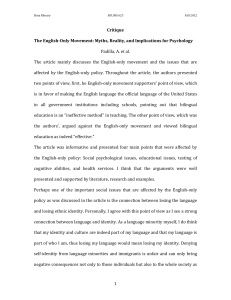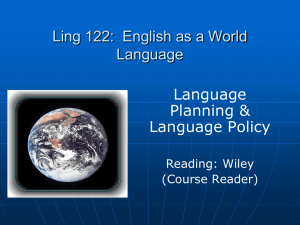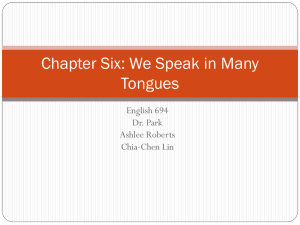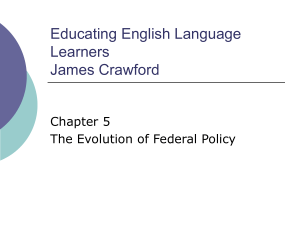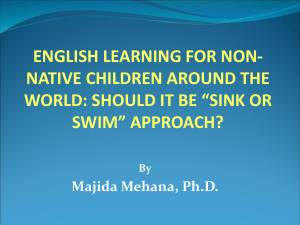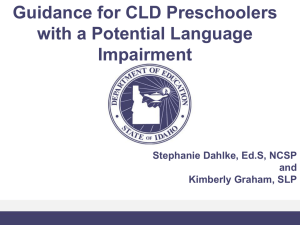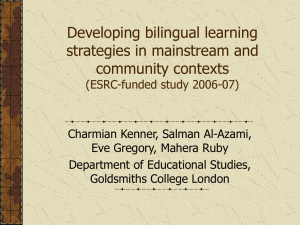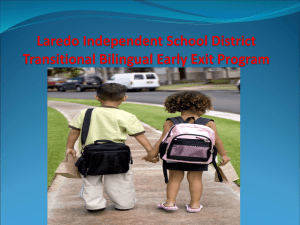History of Bilingual Education in the US
advertisement
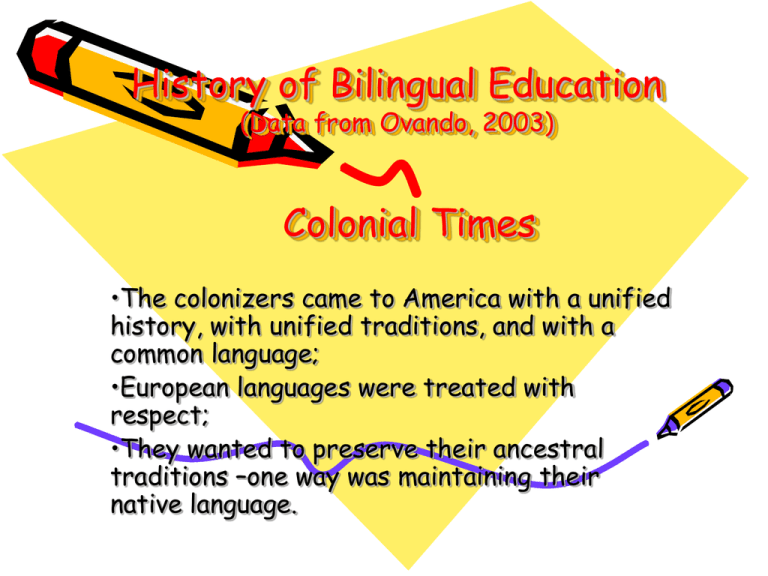
History of Bilingual Education (Data from Ovando, 2003) Colonial Times •The colonizers came to America with a unified history, with unified traditions, and with a common language; •European languages were treated with respect; •They wanted to preserve their ancestral traditions –one way was maintaining their native language. • Neither an official language nor a governmentsanctioned body to regulate speech were adopted; • Period marked by the absence of a consistent language ideology; • However, debate over official English has been present creating resentment and a variety of pedagogical practices. 1700’s to 1880s: Permissive Period Period marked by linguistic tolerance •inconsistency regarding language ideology; •“Defensive Pluralism” (Havinghurst, 1978), preservation of maternal language and cultures; •Czech was taught in Texas, French in Louisiana, and Spanish in the Southwest; German, Swedish, Norwegian, Danish in the northern states •1900: 600,000 children, 4% of the elementary school population received instruction in German; 1880s to 1960s: Restrictive Period Linguistic and immigration restrictionism; repressive policies •1889, American Protective Association promoted English-only schools; •1906 Naturalization Act: English required for naturalization; •1918 to 1920, the Bureau of Naturalization and the Bureau of Education of the US provided funds for the teaching of English skills; • 1923, English-only instruction was offered in 34 states; • War World I: Anti-German hostility during resulted in push for monolingualism; teaching of German was eliminated in most districts; • Americanization of classes and English-only curriculum were the rule to prepare immigrants for assimilation to the mainstream society; • Language was used as a unifying force; • Submersion/swim or sink practices were the rule in language teaching; • Students themselves had to make all linguistic, academic and cultural adjustments • 1923, Meyer v. Nebraska decreed that the prohibition to teach foreign languages was unconstitutional; law had no effect on promoting bilingual education; • English-only measures were a means to maintain colonial domination; however, the debate over the role of the mother tongue continued; • Linguistic and cognitive theories and research findings blamed bilingualism for academic failure and mental retardation; • English was the language of the educated; • Ignorance of English was attributed to inferior intelligence. 1960s to 1980s: Opportunist Period Period marked by the need to create bilingual programs and by laws enforcing bilingual education • Massive school failure prompted bilingual education. Isolated bilingual programs were created with the following characteristics: – English and the students’ native language was used in all grades for language and content instruction; – Some included English-speakers; – Programs were examples of excellence. •World War II: after the war, the government saw the need to foreign language education; 1958, National Defense Education Act: promoted foreign-language education in the US; •1964 Civil Right Act; fostered linguistic diversity; rebirth of instruction in other languages brought changes in immigration laws; •1965 Immigration Act: ended the Naturalization Acts of 1906 and the 1924 national origin quota system, allowing Asians and Latin American to enter the country--more language-minority students appeared in US classroom. • 1963, first two-way bilingual education program at Coral Way Elementary School in Dade County, FL; • 1968, Bilingual Education Act --Title VII of the Elementary and Secondary Education Act: – it constituted a significant step in moving away from English-only measures and Darwinian sink-or-swim practices; – Schools receiving funding were accountable for academic progress of their LEP population; – Act began to undermine English-only laws. • Many elementary and some secondary BE programs and ESL programs were initiated, especially in the Southwest; • Many states reversed the English-only laws enacting enacted transitional bilingual education. • Bilingual Program characteristics: – Native language was used to initiate instruction; English was taught as a second language, and later introduced in instruction; – Bilingual education was an educational strategy to address the needs of the ELL– the native and the mainstream language did not have the same status. • 1974, Lau v. Nichols: – verdict abolished the sink-or-swim practices of the past; – Led to the 1974, Equal Educational Opportunities Act expanding bilingual practices to all schools; • 1975 Lau Remedies: provided guidelines for bilingual education, suitable pedagogical strategies and the importance of moving ELL’s into mainstream classrooms in a timely fashion: – recommended bilingual education as the best approach for elementary education; – law contained instructions for identification, assessment, and mainstreaming of students; – Program was to be implemented at districts with 20 or more LEP at the same grade level representing the same language; – BE programs must be based on sound theoretical approach; – BE aimed at biliteracy and biliculturalism. • 1981, Castañeda v. Pickard: verdict established a 3-step test for determining whether school districts were taking the appropriate action to educate ELL’s; – Program must be based on sound educational theory anchoring school plan; – adequate resources and personnel; – program must reflect sound practices and language and academic results. • 1972, US Commission of Civil Rights found that only a small percentage of LEP’s were receiving bilingual instruction violating legislature 1980 to Present •Under construction
